関連イベント
Highlights and Composition
Prologue Ukiyo-e and Hokusai: A Quick Guide
What are Ukiyo-e ?
Who was Katsushika Hokusai (1760-1849)?
1. First, see Hokusai’s works
The Thirty-six Views of Mount Fuji are iconic!〈Prints—polychrome prints and privately commissioned prints〉
from illustrating novels to creating drawing manuals?!〈Woodblock printed books〉
A painting created directly with Hokusai’s own brush!〈Brush-drawn paintings〉
2. Examining them and discovering the “Wow!”
1. Find shared features
2. Note what’s different
3. Look at the picture, and what do you discover?
Prologue Ukiyo-e and Hokusai: A Quick Guide
What are Ukiyo-e ?
The term ukiyo had, by the Edo period, when Hokusai was alive, come to mean “contemporary” or “presentday.” Ukiyo-e are depictions of the lives of the common people and other contemporary subjects during the Edo period. The people who drew them are called ukiyo-eshi, ukiyo-e artists.
Ukiyo-e include nikuhitsu-ga, brush-drawn paintings, which the artist creates directly, and mokuhanga,woodblock prints, which are produced by a division of labor organized by the hanmoto or producer: the artist created the drawing, the carver prepared the many woodblocks needed to print it, and the printer used them to pull the final image. These works could be hanga, prints created as stand-alone works, or hanpon, woodblock-printed books, such as Sketches by Hokusai.
Who was Katsushika Hokusai (1760-1849)?
Hokusai was an ukiyo-e artist active in the latter half of the Edo period whose signature works include the series Thirty-six Views of Mount Fuji. He made his debut as an ukiyo-e artist at the age of twenty and was active as an artist throughout his life, until his death at the ripe old age of almost ninety. His work was also carried overseas and had a great influence on artists in other countries.
1. First, see Hokusai’s works
The Thirty-six Views of Mount Fuji are iconic!
〈Prints—polychrome prints and privately commissioned prints〉
This iconic print from the Thirty-six View of Mount Fuji depicts Mount Fuji as seen off short of the Kanagawa post station on the Tōkaidō road (now Kanagawa Ward, Yokohama). The boats visible between the waves are oshiokuribune, fast cargo boats that rapidly transported fresh seafood from Edo Bay (now Tokyo Bay) and nearby regions to Edo. This work presents the contract between the huge wave, rising powerfully, spray surging, the people in the boats being shaken by it, and the tranquilly standing Mount Fuji. Known overseas as The Great Wave and used for the design of the back of Japan’s 1000-yen note since July of 2024, this print is familiar throughout the world.
.jpg)
from the series Thirty-six Views of Mount Fuji,
The Sumida Hokusai Museum (all terms) *
*The work will be replaced with different print of
same title during the period

Repeated triangles
resembling Mt. Fuji!?
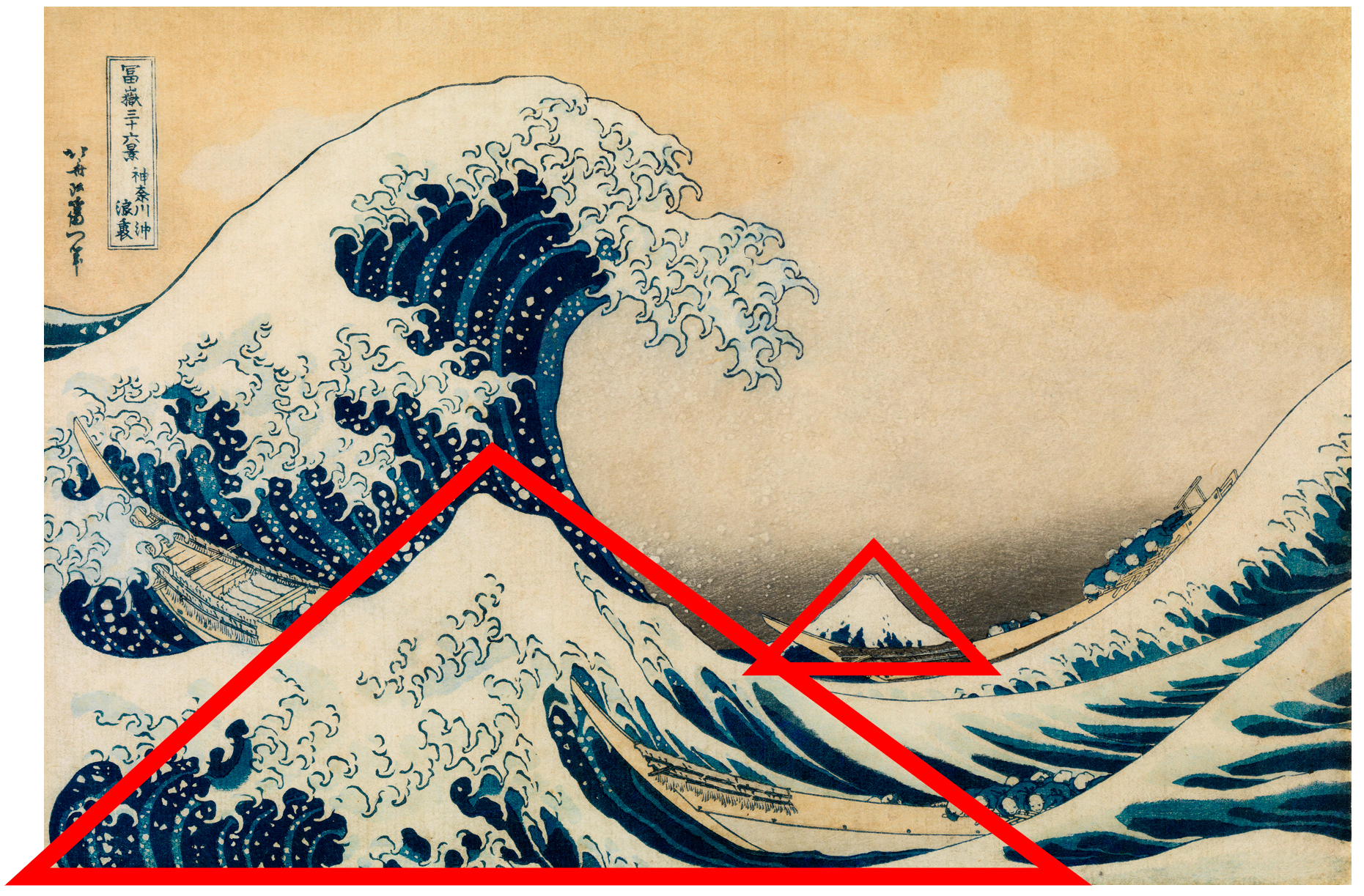
from illustrating novels to creating drawing manuals?!
〈Woodblock printed books〉

Facing Yasuna and their Son, Reports that Akuemon Is Their Enemy,
from Revenge for Kuzunoha, Vol. 4, The Sumida HokusaiMuseum (all terms)

The place where pale ink was used has been
eliminated in a late impression.
Instead, there is a large blank space.
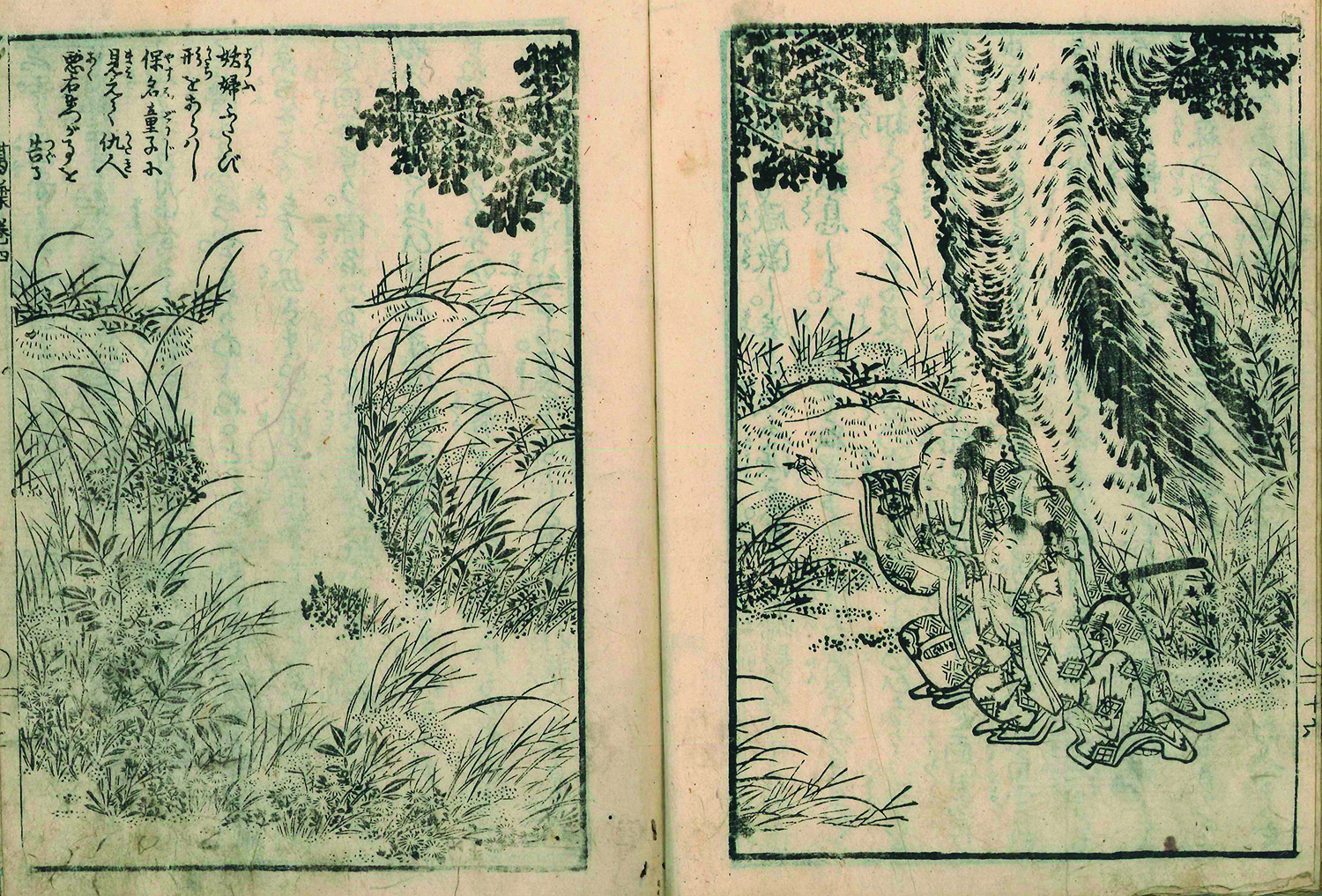
A painting created directly with Hokusai’s own brush!
〈Brush-drawn paintings〉
Hokusai is thought to have produced this painting of seven types of fish and shellfish, in his early forties: hermit crab, mussel, abalone, squid, inshore fish, shrimp, and pen shell. The unique texture of fish and shellfish is expressed using techniques such as "tarashikomi," which makes use of the ink's bleeding, and "tsuketate," which involves laying the brush flat to create shading.

The Sumida Hokusai Museum (1st term)

The white parts of the squid and abalone were painted in gofun,
a white pigment made from
powdered seashells, and sumi ink!
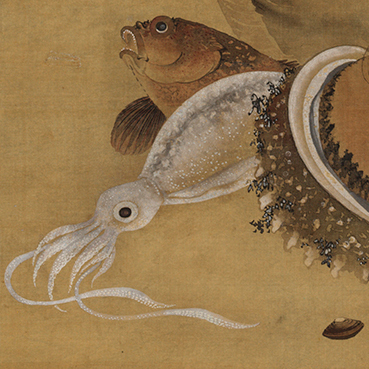
2. Examining them and discovering the “Wow!”
1 Find shared features
Tōtoumi was the name of a province in the western part of today’s Shizuoka prefecture. Hokusai has depicted workers splitting logs and turning them into lumber. Beneath the massive piece of lumber, we can see a craftsman sharpening his saw, a woman carrying a baby on her back, and a boy minding the fire.

Province, from the series Thirty-six Views of Mount
Fuji, The Sumida Hokusai Museum (all terms) *
*The work will be replaced with different print of the same
title during the period.
This print is from Hokusai’s series on the A Hundred Poets, One Poem Each poem anthology. Its subject is a waka poem by the Heian-period poet Harumichi no Tsuraki on autumn leaves flowing down a river, but here the focus is on craftsmen sawing lumber. Under the large piece of lumber, we see, as in In the Mountain of Tōtoumi Province, a worker sharpening his saw, plus a man probably fishing. A mother and child, who is leading his turtle, are crossing thebridge.
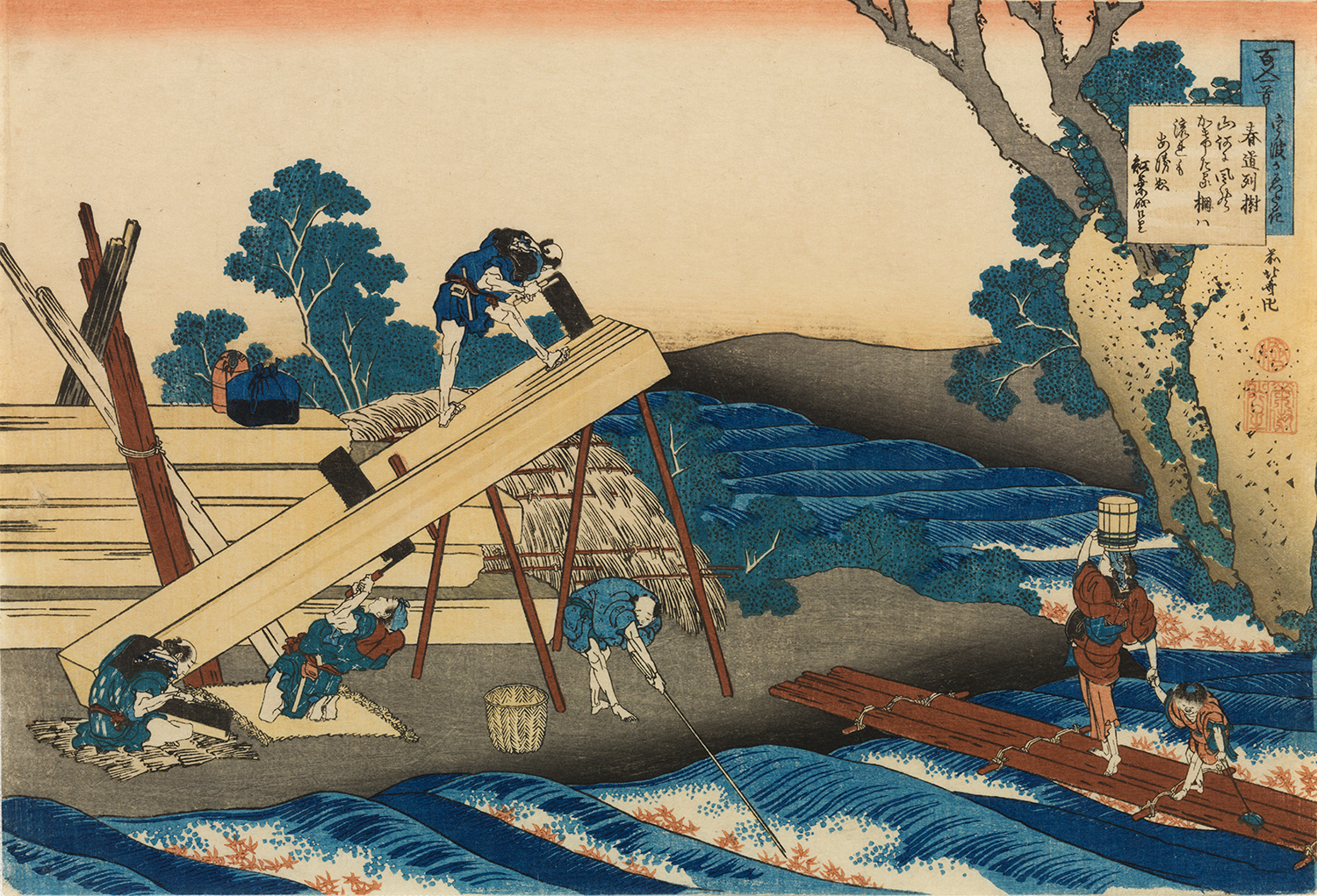
series One Hundred Poems Explained by a Nurse,
The Sumida Hokusai Museum (2nd term)

So many triangles are hidden here!
Cleverly worked out composition with
the lumber and supports create repeated triangles.

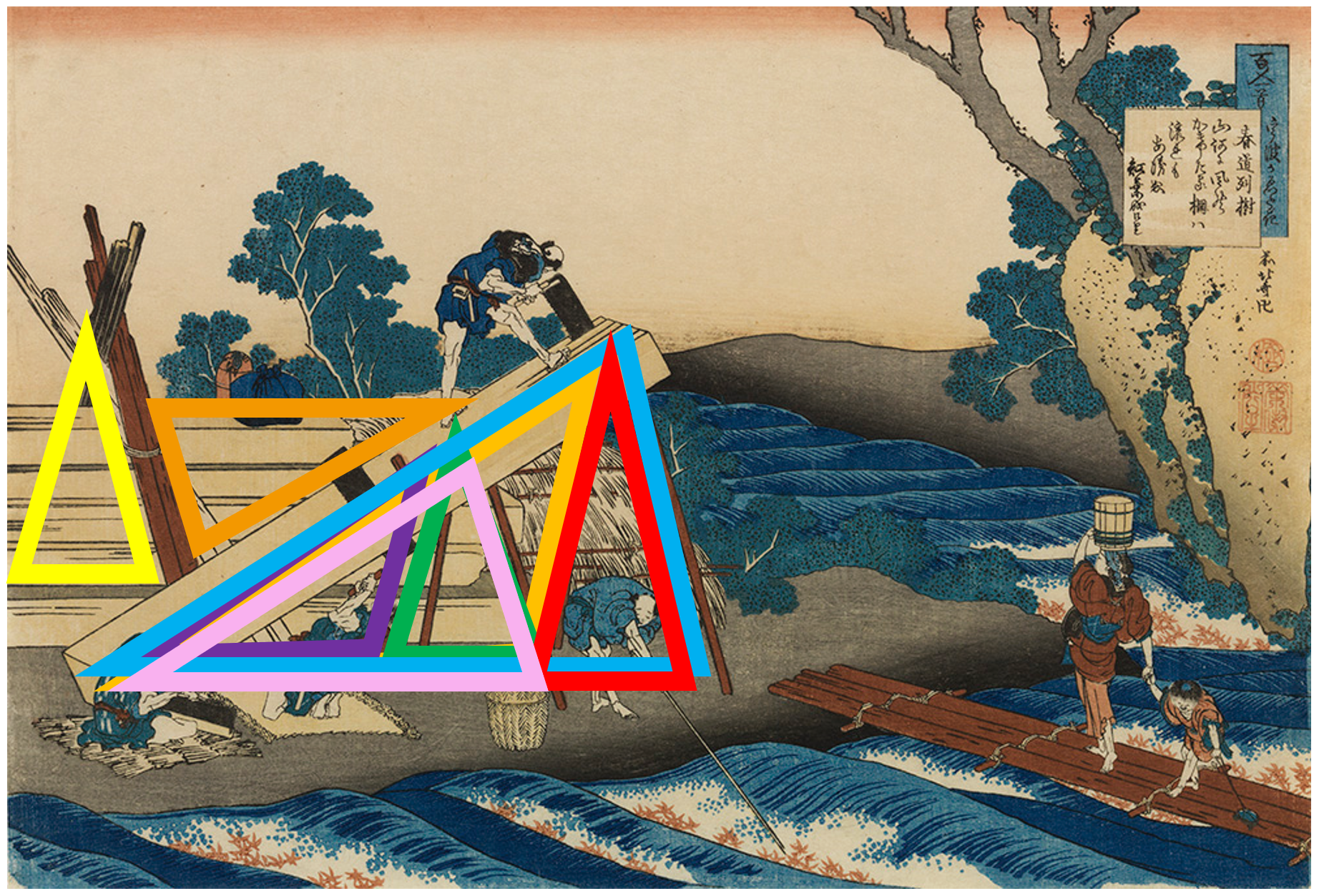
2 Note what’s different
Black clouds envelop the foothills, thunder is rumbling, lightning striking. In the sky above, however, clouds are floating in the blue sky. By depicting two contrasting weather events centered on Mount Fuji, Hokusai express how large and tall the mountain is. This print, along with Under the Wave off Kanagawa and Fuji Under Clear Skies, is one of the iconic images from the Thirty-six Views of Mount Fuji series. The lightning bolt, by the way, is the basis for the design of the Sumida Hokusai Museum’s logo.
_%E7%B8%A6%E9%85%8D%E7%BD%AE_%E5%A4%96%E6%9E%A0%E3%81%8C%E4%BF%9D%E8%AD%B7%E3%82%A8%E3%83%AA%E3%82%A2-01.jpg)
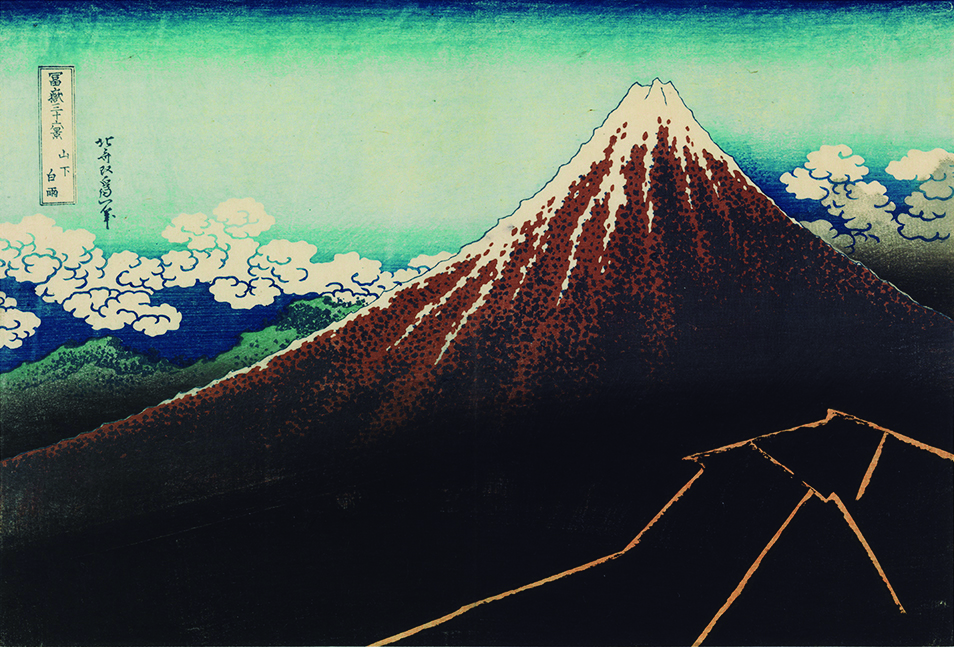
from the series Thirty-six Views of Mount Fuji,
The Sumida Hokusai Museum (1st term)

from the series Thirty-six Views of Mount Fuji,
Yoshino Gypsum Collection, deposited in The Sumida
Hokusai Museum (2nd term)

the series Thirty-six Views of Mount Fuji (Variant Edition),
The Sumida Hokusai Museum (2nd term)

The same title, but each picture is a little differnt.
3 Look at the picture, and what do you discover?
The Gohyaku Rakanji Temple was located in today’s Koto City, Tokyo. The official name of the Sazaidō is Sansōdō. The inside has a threelayered spiral structure, which resembles a turban shell, sazai in Japanese, hence it was also called Sazaidō. Here the structure of the building and the postures of the people there produce a composition inviting our eyes to view Mount Fuji.

Rakanji Temple, from the series Thirty-six Views of
Mount Fuji, The Sumida Hokusai Museum (all terms)*
*The work will be replaced with different print of the same
title during the period.

From somewhere,
birds singing...
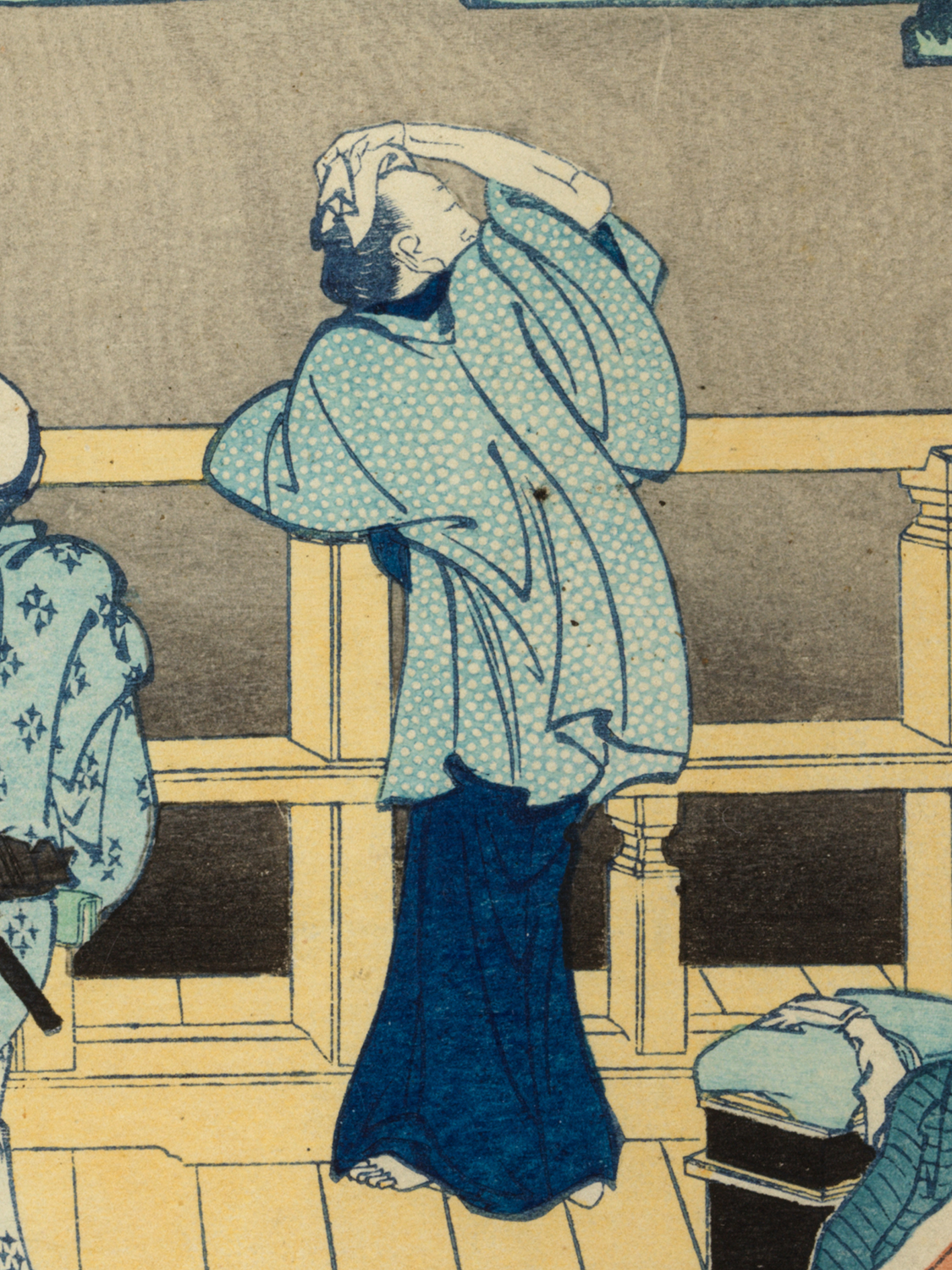

List of Works
Admission Fee
|
|
|
|
|---|---|---|
|
|
|
|
|
|
|
|
|
|
|
|
|
|
|
|
|
|
|
|
|
|
|
|
Tickets are available online for specific dates and times.
Skip the line at reception by booking in advance at the link below.
Note: Availability is limited.
Official Online Ticket site
・Junior high, high school, and university students (including technical college, vocational school, and special training college students) will be requested to show student ID.
・Adults 65 and over will be requested to show a document verifying age.
・Persons with a certificate such as the following plus one accompanying person are admitted at a discount charge: physical disability, intellectual disability, rehabilitation, mentally handicapped health and welfare, atomic bomb victim health notebook, etc. (Please show your certificate at time of admission.)
・Use of these tickets is limited to the day visitors view the exhibiions and allows you to see also "Education Room-Discover Hokusai-" and Permanent Exhibition Plus.
・For group visit, reservation in advance is required. See For Group Visitors.
・For school group visits and field trip programs, reservation in advance is required. See For Teachers.
・After tickets have been purchased, Changes and refunds cannot be made after . However, refunds will be made only in the event of a museum closure due to inevitable force.
Exhibition Leaflet
Original leaflet filled with highlights of the exhibition will be sold from June 24,2025.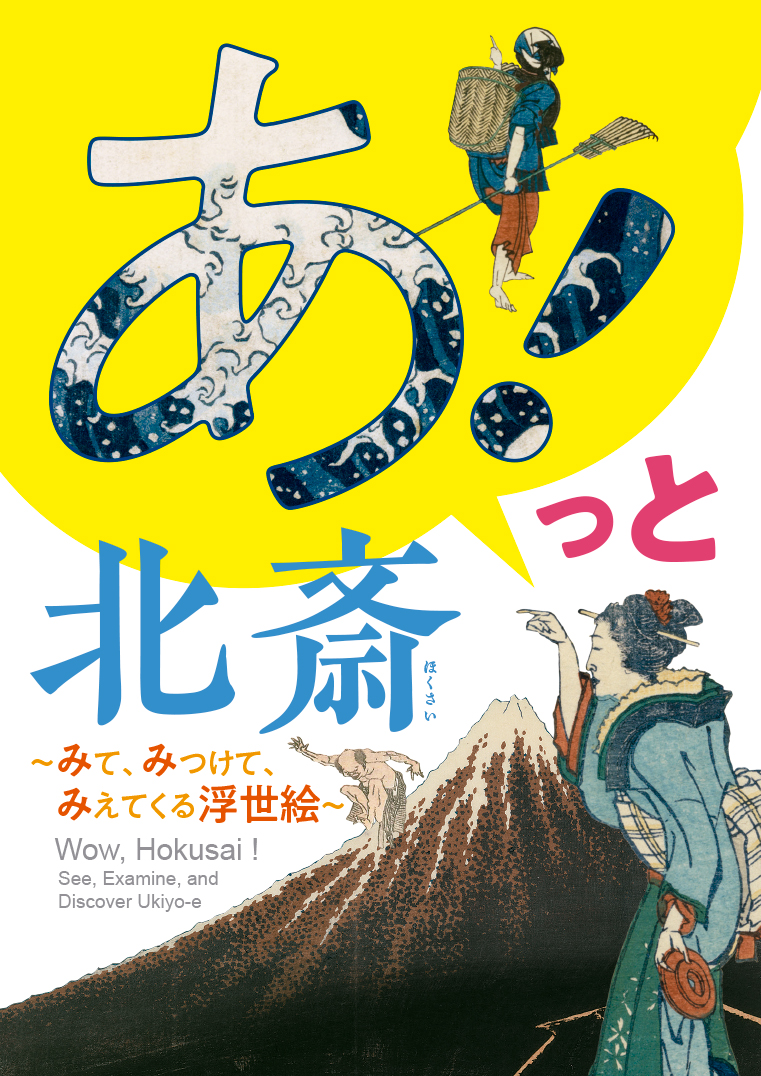
| Title | Wow, Hokusai! See, Examine, and Discover Ukiyo-e |
| Price | ¥350 (tax included) |
| Format | Full Color/A4 size/8 pages in all |
| Release Date | June 24, 2025 |
| Location | Museum Shop, 1F, Sumida Hokusai Museum |
